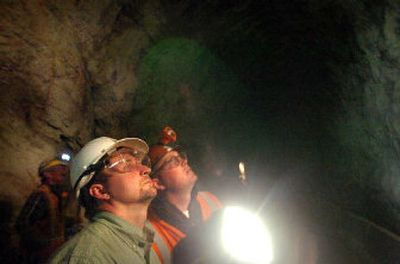Bike trail work rolling along

WALLACE, Idaho – Tunnel reinforcement work will continue for at least another three weeks along portions of the Route of the Hiawatha, a popular rails-to-trail bike path that crosses the Bitterroot Divide along the Montana-Idaho border.
The route will remain closed until all the tunnels are certified safe, which could be as early as mid-June, but more likely the route won’t reopen until the first weekend in July, said Larry Shepherd, a construction engineer for the U.S. Forest Service. The 15-mile route follows the bankrupt Milwaukee Road rail line. A network of seven trestles carries cyclists high over the forest canopy, while the trail’s ten tunnels offer bursts of cool, dark riding.
About 20,000 cyclists ride the Hiawatha each summer. The $160,000 worth of tunnel work was needed after an incident in September when several desk-sized chunks of rock tumbled from the roof of Tunnel 21, which is the second tunnel downhill from the Taft trailhead. About a dozen cyclists were on the trail at the time, though none was in the tunnel.
The construction is delaying the opening of the route, but the improvements are hoped to keep the route safe for years to come, Shepherd said. Snow sheds at either end of many of the tunnels also are being replaced in a separate, $330,000 project.
Without the work, “we would have had to probably close the facility because of the risk,” Shepherd said.
A crew from Hardrock Tunnel Contractors, of Las Vegas, is working in the tunnels boring out loose rock and installing 164 massive bolts to stabilize loose slabs.
A month ago, 5 feet of snow covered much of the trail, making it difficult to access the site. Snowplows were brought in to speed up the work, said Jim Gebhardt, forest engineer for the Idaho Panhandle National Forests.
Lookout Pass Ski Area operates the trail under a contract with the Forest Service. The ski area inspects the trail daily, but the federal government is in charge of major maintenance. Much of the work is being funded by the Idaho Panhandle Resource Advisory Committee, a citizens’ group that reviews and directs federal funding to projects across the national forest.
Although the Hiawatha is considered one of the nation’s “crown jewel” bike trails, keeping the route open requires considerable work, Gebhardt said. Bitter cold winters, intense summer sun and torrents of snowmelt are constantly shifting argillite rock slabs above the tunnels. “That’s one thing about them,” Gebhardt said, “they’re almost like a living, breathing creature.”
Some of the loose rocks have been scraped away, but many of the fissures run deep. These slabs will be secured together with 10-foot-long bolts as wide as a thumb and held in place by epoxy cement. The work is being inspected by Tyler Stephens, an engineer with Shannon and Wilson Geotechnical Consulting, of Seattle. Such bolts are the standard for securing tunnels, but it’s impossible to fully secure the tunnels against the forces of nature.
“This may be good for 20 or 30 years, but we may have to be back in a year or two,” Stephens said, while watching workers place bolts earlier this week.
Maintaining the Hiawatha might seem expensive, but it’s nothing compared with the original cost of building the route. Construction began 99 years ago on the trans-Bitterroot passage. It took 9,000 workers and $234 million to complete this last leg in the transcontinental route for the Chicago, Milwaukee and Puget Sound Railway Co., according to a history compiled by the U.S. Forest Service. Not only did the line help link the nation, but it also transported vast amounts of timber and minerals from the Bitterroots.
Using an inflation calculator supplied on the Web site of the Federal Reserve Bank of Minneapolis, $1 million when the railroad was built would be worth about $20 million today, making the cost of building such a route today nearly incomprehensible. The Taft Tunnel alone, which is 1.7 miles long, would be “a multibillion dollar project,” today, said Stephens, the geotechnical consultant.
The Milwaukee Road ended in bankruptcy, and the last train chugged through the tunnels of the route in 1980.